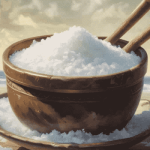When choosing the right salt for your culinary or health needs, the options can seem overwhelming. Among the many varieties available, sea salt and Celtic salt are often compared due to their natural origins and mineral content.
However, while they share some similarities, they are not the same. In this blog post, we’ll dive into the differences between Celtic and sea salt, their health benefits, and how to use them effectively in your daily life.
Quick Summary
No, Celtic salt is not the same as sea salt. It is a specific type of sea salt, harvested using traditional methods, with a distinct mineral content and moisture level.
Are Celtic and Sea Salts the Same Thing?
Celtic salt is a type of sea salt, but it’s not the same as regular sea salt. Celtic salt and sea salt are derived from the evaporation of seawater, but they differ in their harvesting methods, mineral content, moisture levels, and flavor.
Harvesting Methods
Sea Salt: Sea salt is typically harvested from evaporated seawater, often using modern techniques. It can then be further processed and refined to remove impurities and create different textures, such as fine or coarse grains.
Celtic Salt: Celtic salt, also known as Sel Gris or “gray salt,” is harvested using traditional methods, particularly along the Brittany coast of France. It is hand-raked from salt ponds lined with clay, which gives it a distinctive gray color. The salt is collected when it’s still moist, which helps it retain a higher mineral content.
Mineral Content
Sea Salt: Regular sea salt contains trace minerals like magnesium, calcium, and potassium, but the amount and variety can vary depending on the source. Some sea salts are processed to remove these minerals, producing a purer sodium chloride product.
Celtic Salt: Celtic salt is renowned for its rich mineral content, including magnesium, potassium, calcium, iron, and zinc. These minerals contribute to its unique flavor and are preserved by traditional harvesting methods.
Moisture Levels
Sea Salt: Most salts are relatively dry, especially if processed and refined. Depending on how they are processed, they are available in fine, coarse, or flake forms.
Celtic Salt: Celtic salt is known for its high moisture content. This is because it is harvested while still damp and retains water due to its natural composition. The moist texture of Celtic salt makes it different from other types of sea salt.
Color and Flavor
Sea Salt: The color of sea salt can vary from white to gray to pink, depending on its mineral content and origin. The flavor is typically mild, though it can have subtle differences depending on the minerals present.
Celtic Salt: Celtic salt has a characteristic gray color due to the clay in the salt ponds where it’s harvested. Its high mineral content makes its flavor more robust and briny than regular sea salt.
Usage
Sea Salt: Sea salt is versatile and widely used in cooking, baking, and seasoning. Fine sea salt is commonly used for everyday cooking, while coarse sea salt is popular for grilling and roasting.
Celtic Salt: Due to its coarse, moist texture and strong flavor, It is often used as a finishing salt. It’s sprinkled over dishes before serving to enhance flavor and add texture.
Health Benefits of Celtic Salt
Celtic salt is often praised for its health benefits, attributed to its rich mineral content. Here are some potential benefits:
Electrolyte Balance: The minerals in Celtic salt, such as magnesium and potassium, help maintain the body’s electrolyte balance, which is crucial for proper hydration and muscle function.
Digestive Health: Celtic salt may support digestive health by stimulating the production of digestive enzymes and hydrochloric acid in the stomach, aiding in better healthy digestion and nutrient absorption.
Alkalizing Properties: Some proponents of Celtic salt suggest that it has alkalizing properties, helping to balance the body’s pH levels, which can contribute to overall health.
Detoxification: The trace minerals in Celtic salt are believed to support the body’s natural detoxification processes by promoting kidney function and helping to eliminate toxins.
Skin Health: Celtic salt can also be used in skincare routines, particularly bath soaks, to promote healthy skin. The minerals can help soften and exfoliate the skin, while the salt’s natural properties may soothe conditions like eczema or psoriasis.
How to Use Celtic Salt and Sea Salt?
Here’s a detailed guide on how to use Celtic salt and sea salt effectively:
In Cooking
Celtic Salt: Due to its robust flavor and coarse texture, It is best used as a finishing salt. Sprinkle it over dishes just before serving to enhance the flavor and add a bit of crunch.
Sea Salt: Fine sea salt is versatile and can be used in everyday cooking, baking, and seasoning. Coarse sea salt is great for grilling or roasting, where it can add texture and flavor to dishes.
In Health Routines
Celtic Salt: Consider adding a pinch of Celtic salt to your water or beverages to help with hydration, especially after exercise. It can also be used in detox baths to draw out impurities and nourish the skin health.
Sea Salt: Sea salt can also be added to baths or used in homemade scrubs. Due to its exfoliating and purifying properties, it’s a common ingredient in natural beauty products.
How to Choose Between Celtic Salt and Sea Salt?
When deciding between Celtic salt and sea salt, there are a few key factors to consider:
Flavor Preference: Celtic salt may be the better choice if you’re looking for a more complex, subtly briny flavor. High-quality sea salt may be the way to go for a more straightforward, oceanic taste.
Mineral Content: As we’ve discussed, Celtic salt generally contains a more diverse array of essential minerals, making it the healthier option if you’re looking to maximize your mineral intake.
Texture and Appearance: The coarse, grey crystals of Celtic salt can provide a nice textural contrast, while the varied flake sizes and colors of sea salt offer a more visually appealing option for certain dishes.
Cooking Technique: The finer grains of some sea salts may be better suited for certain cooking methods, such as baking or seasoning during the cooking process. In contrast, the heartier texture of Celtic salt makes it an excellent choice for finishing dishes.
Ultimately, deciding between Celtic and sea salt depends on your taste preferences, dietary needs, and the specific dish you’re preparing. Experimenting with both varieties can help you discover which best suits your culinary preferences.
Conclusion
While Celtic salt and sea salt share common origins, they are different. Celtic salt’s traditional harvesting methods, higher mineral content, and unique flavor profile set it apart from other sea salts.
Whether you’re looking for health benefits, a distinctive taste, or a versatile cooking ingredient, understanding the differences between these salts can help you make informed choices.
By exploring the world of natural salts, you can enhance your culinary creations and potentially improve your health while enjoying the rich flavors and textures these salts bring.
Also Read:
https://inmybowl.com/how-much-celtic-sea-salt-should-you-consume-per-day/



